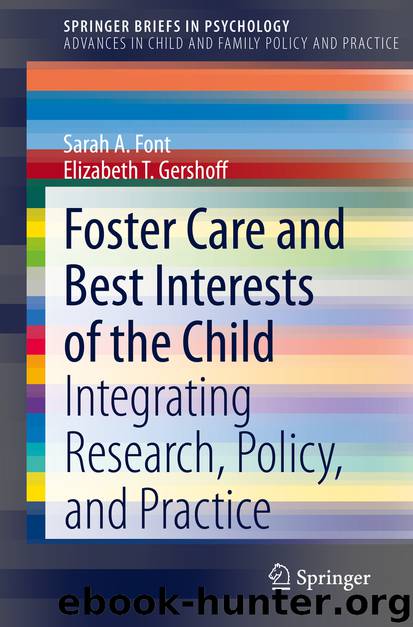Foster Care and Best Interests of the Child by Sarah A. Font & Elizabeth T. Gershoff

Author:Sarah A. Font & Elizabeth T. Gershoff
Language: eng
Format: epub
ISBN: 9783030411466
Publisher: Springer International Publishing
3.3 Argument 3: The Decision to Use Foster Care Is Biased
Numerous scholars have argued that the decision to use foster care is affected by racial and class biases. Research in this area attempts to differentiate disproportionate representation in the foster care system that is due to differences in the risks children face from differences that are due to differential treatment or discrimination. Concerns about racial bias are largely focused on Black and, to a lesser extent, Native American families, as prior research indicates Asian children are removed at lower rates than all other groups, and Hispanic children are removed at rates similar to non-Hispanic White children (Maguire-Jack, Font, & Dillard, 2020; Wildeman & Emanuel, 2014).
Black and Native American children are indeed overrepresented in foster care. In 2016, about 76,000 Black children entered foster care, accounting for 27.8% of entries. Nationally, approximately 15% of the child population is Black, with an additional 2% of children identified as Black and another race (Child Trends, 2018). Native American children constitute less than 1% of the population and approximately 3.4% of foster care entries. Thus, Black children are nearly twice as likely, and Native American children more than thrice as likely, to enter foster care than would be predicted if their rate of foster care entry was equal to their proportion in the overall population. Disproportionality for Black children has declined from 2002, when approximately 84,000 Black (alone or mixed race) children entered foster care and accounted for 30.7% of foster care entries. In contrast, disproportionality among Native American children remains persistently high.
Among those involved with the child welfare system, Black children are not systematically more likely to be put in foster care than children of other races or ethnicities. According to the 2016 child file from the National Child Abuse and Neglect Data System, approximately 28% of children investigated by CPS in 2016 were Black (alone or mixed race), essentially identical to the 28% of children who entered foster care that year who were Black. The representation of Black children among child maltreatment fatalities (31–38%) is similar to, if not higher than, their representation among children with CPS investigations (Klevens & Leeb, 2010; Palusci & Covington, 2014; U.S. Department of Health and Human Services, 2019). Nationally, Native American children are more overrepresented in foster care entries than in CPS investigations, which may reflect their population concentration in states with higher rates of removal, as well as racial bias. Due to their small representation in the overall population, few additional data points are available to shed light on causes of overrepresentation among Native American children.
Why are Black children overrepresented in CPS investigations in the first place? One reason appears to be that Black children are maltreated at higher rates than other children. The fourth National Incidence Study (NIS-IV), conducted by the Children’s Bureau and the U.S. Office of Planning, Research and Evaluation, attempted to estimate the total incidence of child maltreatment, including that which was not reported to CPS. The study found that Black
Download
This site does not store any files on its server. We only index and link to content provided by other sites. Please contact the content providers to delete copyright contents if any and email us, we'll remove relevant links or contents immediately.
Rewire Your Anxious Brain by Catherine M. Pittman(18553)
Talking to Strangers by Malcolm Gladwell(13222)
The Art of Thinking Clearly by Rolf Dobelli(10221)
Mindhunter: Inside the FBI's Elite Serial Crime Unit by John E. Douglas & Mark Olshaker(9201)
Becoming Supernatural by Dr. Joe Dispenza(8119)
Change Your Questions, Change Your Life by Marilee Adams(7635)
Nudge - Improving Decisions about Health, Wealth, and Happiness by Thaler Sunstein(7615)
The Road Less Traveled by M. Scott Peck(7522)
The Lost Art of Listening by Michael P. Nichols(7406)
Enlightenment Now: The Case for Reason, Science, Humanism, and Progress by Steven Pinker(7235)
Mastermind: How to Think Like Sherlock Holmes by Maria Konnikova(7227)
Win Bigly by Scott Adams(7094)
The Way of Zen by Alan W. Watts(6506)
Daring Greatly by Brene Brown(6445)
Big Magic: Creative Living Beyond Fear by Elizabeth Gilbert(5611)
Grit by Angela Duckworth(5523)
Ego Is the Enemy by Ryan Holiday(5294)
Men In Love by Nancy Friday(5155)
Altered Sensations by David Pantalony(5045)
